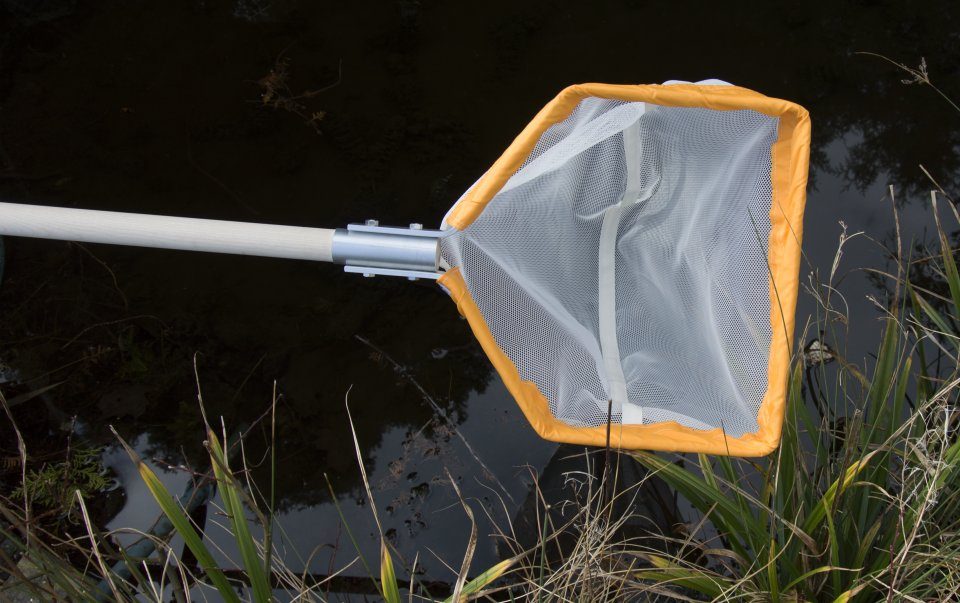Global Positioning System (GPS) | |

A GPS unit is one of the most useful pieces of equipment for reptile and amphibian survey. A small battery-powered hand-held unit receives radio transmissions from a constellation of satellites, providing the user with an accurate position of where they are standing on the ground. Many different co-ordinate systems can be used, but the most useful function is to provide an accurate* Ordnance Survey grid reference for the user's location. Accurate positioning is useful for recording the precise location of animal sightings, but the GPS unit has other tricks, equally useful. You can enter a grid reference, and the GPS unit can help you to find the location by showing an arrow in the direction you should walk, and a distance from the target spot. This is feature is usually used to find refugia (tins) for reptile survey, but can be just as useful to find your car park after a long countryside walk. GPS units should be robustly constructed, and ideally be a bright colour, as you will drop it at some point! For connectivity with modern computers, you will find that a GPS unit with a USB port is the best option. SARG recommends the Garmin eTrex 10 GPS. This basic unit has all of the essential functions, is robustly made and it's bright colour means that it is easily found when dropped in vegetation. The Garmin eTrex 10 GPS costs around £100.00 new, or secondhand units can be purchased for around £40.00. [Search Ebay for a Garmin eTrex 10 GPS]. A great piece of software to use with GPS units is the free, downloadable EasyGPS application: http://www.easygps.com/ This unit works very well with two rechargeable AA batteries. It is good practice to fit freshly charged batteries before every survey. See the rechargeable battery section for recommendations. * Actually using the British grid system will generate errors of a few metres. GPS units are calibrated to provide WGS84 coordinates accurately, and use a relatively simple 'Molodensky' algorithm to convert this to OSGB local grid references. If you want super-accuracy, record WGS84 coordinates. In most cases, the OSGB reference is good enough. | |
| Steve Langham - updated April 2017 | |
Rechargeable Batteries | |

Rechargeable batteries can be a useful and cost-effective means of powering hand-held devices such as GPS units. Fitting your equipment with freshly charged batteries reduces the liklihood of them running out whilst in the field. The most common size of battery for portable devices suitable for rechargeable batteries is the 'AA' size. The key characteristics for rechargeable batteries are:
Although not the cheapest option, SARG have found that the Panasonic eneloop pro batteries offer by far the best performance. These batteries will retain 85% of their charge, after having been sat on a shelf for 12 months and can be recharged at least 500 times. Panasonic eneloop (standard) batteries perform even better, but are not available in the higher capacities. | |
| Steve Langham - updated April 2017 | |
Location Smartphone Apps | |
|
We have yet to conduct a thorough analysis of smartphone apps which can replace the functionality of a hand-held GPS unit. However, the following apps may be useful. The Grid Reference app is free, and displays the UK Ordnance Survey (OS) Grid Reference based upon your current location. Usefully, it can display your current location to 10 digit precision. The app is extremely lightweight, but you will have to enable GPS functionality on your phone, which may reduce battery life. This app is ideal for casual sightings, but cannot store waypoints and guide you to them, so has limited value for structured surveys. IOS (Apple) - Commander Compass Lite Unreviewed app, however the specification looks useful. | |
| Steve Langham - updated April 2017 | |
Amphibian Survey Torches | |

The Industry Standard torch for amphibian survey is the Clulite Clubman 1 Million CP torch. Although expensive (the MRP is over £100.00), we have yet to find its equal in terms of dippable beam, beam shape and colour to penetrate water. It is a modular torch system, with all parts being replaceable. The standard, heavy lead-acid battery can be upgraded to the superb Li-ON battery, but at significant extra cost. Essential features for an amphibian survey torch are:
With the advances in LED technology, especially with Cree SiC LEDs it is hoped that a more affordable alternative will become available, but to date, in field testing the Clubman remains the best available torch. A poor alternative, but much more affordable is the Zenon Rechargeable LED Work Light Torch 1 Million Candle Power Spotlight Hand Lamp. Retailing at around £18.00, this is an affordable option which boasts impressive duration and power. However, the light output seems less able to penetrate water than the Clubman, and the beam is a spotlight pattern, less suited to the task that the the Clubman's drivelight pattern. | |
| Steve Langham - updated April 2017 | |
Amphibian Survey Net | |

The Industry Standard net for amphibian survey is the GB Nets Amphibian Net. The Amphibian Net has a 300mm wide frame and lacks a brass inner for bag attachment. Instead, the bag is attached by a wide, velcro collar. This prevents animals from being caught between the frame and bag. The seams have been carefully placed so that they do not come into contact with the front edge of the net, and the material of the bag is a soft 2mm mesh. The handle consists of a single wooden pole which is 1.2m in length. This sturdy net can be used to support the surveyor on uncertain ground and is tough enough to survive frequent encounters with aquatic plants and the pond bottom. Retailing at around £55.00 it is not cheap, however the quality is probably worth the price. | |
| Steve Langham - updated April 2017 | |